Public Willingness to Pay for Farmland Eco-Compensation and Allocation to Farmers: An Empirical Study from Northeast China
Abstract
:1. Introduction
2. Theoretical Framework
3. Materials and Methods
3.1. Survey Area
3.2. Choice Experiment
3.2.1. Attributes and Levels Setting
3.2.2. Experimental Design and Choice Set
3.2.3. Survey and Data Collection
3.2.4. Estimation Procedure
4. Results
4.1. Descriptive Statistics
4.2. Model Estimation
4.3. Payment Allocation and Preference Heterogeneity
4.4. Willingness to Pay and Allocation
4.5. Compensation Surplus Assessment
5. Discussions
5.1. WTP and Allocation
5.2. Public Preferences
5.3. Methodological Implications and Policy Recommendations
6. Conclusions
Supplementary Materials
Author Contributions
Funding
Institutional Review Board Statement
Data Availability Statement
Conflicts of Interest
References
- Food and Agriculture Organization of the United Nations (FAO); Intergovernmental Technical Panel on Soils (ITPS). Status of the World’s Soil Resources-Technical Summary; Food and Agriculture Organization of the United Nations and Intergovernmental Technical Panel on Soils: Rome, Italy, 2015. [Google Scholar]
- Cheng, L.; Jiang, P.; Chen, W.; Li, M.; Wang, L.; Gong, Y.; Pian, Y.; Xia, N.; Duan, Y.; Huang, Q. Farmland protection policies and rapid urbanization in China: A case study for Changzhou City. Land Use Policy 2015, 48, 552–566. [Google Scholar]
- Jin, J.; He, R.; Wang, W.; Gong, H. Valuing cultivated land protection: A contingent valuation and choice experiment study in China. Land Use Policy 2018, 74, 214–219. [Google Scholar] [CrossRef]
- National Bureau of Statistics of China (NBS). China Statistical Yearbook; China Statistics Press: Beijing, China, 2022. [Google Scholar]
- Zhang, W.; Wang, W.; Li, X.; Ye, F. Economic development and farmland protection: An assessment of rewarded land conversion quotas trading in Zhejiang, China. Land Use Policy 2014, 38, 467–476. [Google Scholar] [CrossRef]
- Assessment, M.E. Ecosystems and Human Well-Being: Biodiversity Synthesis; World Resources Institute: Washington, DC, USA, 2005. [Google Scholar]
- Yang, X.; Zhou, X.; Cao, S.; Zhang, A. Preferences in Farmland Eco-Compensation Methods: A Case Study of Wuhan, China. Land 2021, 10, 1159. [Google Scholar] [CrossRef]
- Wunder, S. Revisiting the concept of payments for environmental services. Ecol. Econ. 2015, 117, 234–243. [Google Scholar] [CrossRef]
- Wang, L.; Zheng, W.; Tang, L.; Zhang, S.; Liu, Y.; Ke, X. Spatial optimization of urban land and cropland based on land production capacity to balance cropland protection and ecological conservation. J. Environ. Manag. 2021, 285, 112054. [Google Scholar] [CrossRef] [PubMed]
- Sheng, J.; Wang, H. Community-based incentive coordination in payments for ecosystem services: China’s Wolong Nature Reserve. J. Environ. Plann. Man 2023, 1–25. [Google Scholar] [CrossRef]
- Liu, M.; Wu, W.; Li, H. The Influence of Grassland Ecological Compensation Policy on Grassland Quality: Evidence from the Perspective of Grassland Ecosystem Vulnerability. Agriculture 2023, 13, 1841. [Google Scholar] [CrossRef]
- Lu, Y.; Kong, F.; Huang, L.; Xiong, K.; Xu, C.; Wang, B. Evaluation of the Implementation Effect of the Ecological Compensation Policy in the Poyang Lake River Basin Based on Difference-in-Difference Method. Sustainability 2021, 13, 8667. [Google Scholar] [CrossRef]
- Yue, D.; Sarkar, A.; Cui, Y.; Qian, L.; Minjuan, Z.; Das, J.C. Ecological compensation of grain trade within urban, rural areas and provinces in China: A prospect of a carbon transfer mechanism. Environ. Dev. Sustain. 2021, 23, 16688–16712. [Google Scholar] [CrossRef]
- Song, M.; Jin, G.; Yan, W. Which pro-environmental farming behaviors should be priorities for funding? An approach based on matching ecosystem services (ESs) demand and supply. J. Environ. Manag. 2021, 297, 113368. [Google Scholar] [CrossRef] [PubMed]
- Shang, W.; Gong, Y.; Wang, Z.; Stewardson, M.J. Eco-compensation in China: Theory, practices and suggestions for the future. J. Environ. Manag. 2018, 210, 162–170. [Google Scholar] [CrossRef] [PubMed]
- Wang, P.; Wolf, S.A. A targeted approach to payments for ecosystem services. Glob. Ecol. Conserv. 2019, 17, e00577. [Google Scholar] [CrossRef]
- Song, B.; Zhang, Y.; Zhang, L.; Zhang, F. A top-down framework for cross-regional payments for ecosystem services. J. Clean. Prod. 2018, 182, 238–245. [Google Scholar] [CrossRef]
- Wunder, S. The Efficiency of Payments for Environmental Services in Tropical Conservation. Conserv. Biol. 2006, 21, 48–58. [Google Scholar] [CrossRef] [PubMed]
- Jin, J.; Jiang, C.; Truong, D.T.; Li, L. Public preferences for cultivated land protection in Wenling City, China: A choice experiment study. Land Use Policy 2013, 30, 337–343. [Google Scholar]
- Zandersen, M.; Jørgensen, S.L.; Nainggolan, D.; Gyldenkærne, S.; Winding, A.; Greve, M.H.; Termansen, M. Potential and economic efficiency of using reduced tillage to mitigate climate effects in Danish agriculture. Ecol. Econ. 2016, 123, 14–22. [Google Scholar] [CrossRef]
- Johnston, R.J.; Bergstrom, J.C. Valuing Farmland Protection: Do Empirical Results and Policy Guidance Depend on the Econometric Fine Print? Appl. Econo. Perspect. Policy 2011, 33, 639–660. [Google Scholar] [CrossRef]
- Yu, Z.; Tan, Y.; Wu, C.; Mao, M.; Zhang, X. Alternatives or status quo? Improving fallow compensation policy in heavy metal polluted regions in Chaling County, China. J. Clean. Prod. 2019, 210, 287–297. [Google Scholar] [CrossRef]
- Travisi, C.M.; Nijkamp, P. Valuing environmental and health risk in agriculture: A choice experiment approach to pesticides in Italy. Ecol. Econ. 2008, 67, 598–607. [Google Scholar] [CrossRef]
- Chen, Z.; Zhang, A.; Zhou, K.; Huang, L. Can payment tools substitute for regulatory ones? Estimating the policy preference for agricultural land preservation, Tianjin, China. Land Use Policy 2021, 100, 104860. [Google Scholar] [CrossRef]
- Fischer, A.; Young, J.C. Understanding mental constructs of biodiversity: Implications for biodiversity management and conservation. Biol. Conserv. 2007, 136, 271–282. [Google Scholar] [CrossRef]
- McShane, T.O.; Hirsch, P.D.; Trung, T.C.; Songorwa, A.N.; Kinzig, A.; Monteferri, B.; Mutekanga, D.; Thang, H.V.; Dammert, J.L.; Pulgar-Vidal, M.; et al. Hard choices: Making trade-offs between biodiversity conservation and human well-being. Biol. Conserv. 2011, 144, 966–972. [Google Scholar] [CrossRef]
- Tienhaara, A.; Haltia, E.; Pouta, E.; Arovuori, K.; Grammatikopoulou, I.; Miettinen, A.; Koikkalainen, K.; Ahtiainen, H.; Artell, J. Demand and supply of agricultural ES: Towards benefit-based policy. Eur. Rev. Agric. Econ. 2020, 47, 1223–1249. [Google Scholar] [CrossRef]
- Yu, H.; Xie, W.; Yang, L.; Du, A.; Almeida, C.M.V.B.; Wang, Y. From payments for ecosystem services to eco-compensation: Conceptual change or paradigm shift? Sci. Total Environ. 2020, 700, 134627. [Google Scholar] [CrossRef] [PubMed]
- Quan, T.; Zhang, H.; Li, J.; Lu, B. Horizontal ecological compensation mechanism and green low-carbon development in river basins: Evidence from Xin’an River basin. Environ. Sci. Pollut. Res. 2023, 30, 88463–88480. [Google Scholar] [CrossRef]
- Amaris, G.; Dawson, R.; Gironás, J.; Hess, S.; de Dios Ortúzar, J. Understanding the preferences for different types of urban greywater uses and the impact of qualitative attributes. Water Res. 2020, 184, 116007. [Google Scholar] [CrossRef] [PubMed]
- Cao, Y.; Cao, Y.; Li, G.; Tian, Y.; Xiaoqian, F.; Li, Y.; Tan, Y. Linking ecosystem services trade-offs, bundles and hotspot identification with cropland management in the coastal Hangzhou Bay area of China. Land Use Policy 2020, 97, 104689. [Google Scholar] [CrossRef]
- Yang, X.; Zhang, A.; Zhang, F. Farmers’ Heterogeneous Willingness to Pay for Farmland Non-Market Goods and Services on the Basis of a Mixed Logit Model—A Case Study of Wuhan, China. Int. J. Environ. Res. Public Health 2019, 16, 3876. [Google Scholar] [CrossRef]
- Liu, M.; Liu, W.; Yang, L.; Jiao, W.; He, S.; Min, Q. A dynamic eco-compensation standard for Hani Rice Terraces System in southwest China. Ecosyst Serv. 2019, 36, 100897. [Google Scholar] [CrossRef]
- Engel, S. The Devil in the Detail: A Practical Guide on Designing Payments for Environmental Services. Int. Rev. Environ. Reso. 2016, 9, 131–177. [Google Scholar] [CrossRef]
- Yan, J.; Li, H.; Hua, X.; Peng, K.; Zhang, Y. Determinants of Engagement in Off-Farm Employment in the Sanjiangyuan Region of the Tibetan Plateau. Mt. Res. Dev. 2017, 37, 464–473. [Google Scholar] [CrossRef]
- Bennett, M.T.; Gong, Y.; Scarpa, R. Hungry Birds and Angry Farmers: Using Choice Experiments to Assess “Eco-compensation” for Coastal Wetlands Protection in China. Ecol. Econ. 2018, 154, 71–87. [Google Scholar] [CrossRef]
- Chinese Academy of Sciences (CAS). Northeast Black Soils White Paper (2020); Chinese Academy of Sciences (CAS): Beijing, China, 2021. [Google Scholar]
- Liu, H.; Li, S.; Wu, M.; Sun, F.; Wang, Q.; Dong, X. Current Situation and Perspectives of Black Soil Protection from the Integrated Angle of Quantity, Quality, and Ecology in Northeast China. Chin. J. Soil Sci. 2021, 52, 544–552. [Google Scholar]
- Johnston, R.J.; Boyle, K.J.; Adamowicz, W.V.; Bennett, J.; Brouwer, R.; Cameron, T.A.; Hanemann, W.M.; Hanley, N.; Ryan, M.; Scarpa, R.; et al. Contemporary Guidance for Stated Preference Studies. J. Assoc. Environ. Resour. Econ. 2017, 4, 319–405. [Google Scholar] [CrossRef]
- Train, K.E. Discrete Choice Methods with Simulation; Cambridge University Press: New York, NY, USA, 2012. [Google Scholar]
- Arata, L.; Diluiso, F.; Guastella, G.; Pareglio, S.; Sckokai, P. Willingness to pay for alternative features of land-use policies: The case of the lake Garda region. Land Use Policy 2021, 100, 104942. [Google Scholar] [CrossRef]
- Ministry of Agriculture and Rural Affairs of the People’s Republic of China (MARA). Outline of Northeast Black Soils Protection Plan (2017–2030); Ministry of Agriculture and Rural Affairs of the People’s Republic of China (MARA): Beijing, China, 2017.
- Ministry of Agriculture and Rural Affairs of the People’s Republic of China (MARA). Implementation Plan of the National Black Soils Protection Project (2021–2025); Ministry of Agriculture and Rural Affairs of the People’s Republic of China (MARA): Beijing, China, 2021.
- Johnston, R.J.; Duke, J.M. Willingness to Pay for Agricultural Land Preservation and Policy Process Attributes: Does the Method Matter? Am. J. Agric. Econ. 2007, 89, 1098–1115. [Google Scholar] [CrossRef]
- Schultz, E.T.; Johnston, R.J.; Segerson, K.; Besedin, E.Y. Integrating Ecology and Economics for Restoration: Using Ecological Indicators in Valuation of Ecosystem Services. Restor. Ecol. 2012, 20, 304–310. [Google Scholar] [CrossRef]
- Yuan, Y.; Boyle, K.J.; You, W. Sample Selection, Individual Heterogeneity, and Regional Heterogeneity in Valuing Farmland Conservation Easements. Land Econ. 2015, 91, 627–649. [Google Scholar] [CrossRef]
- Fedotova, A.A. The Origins of the Russian Chernozem Soil (Black Earth): Franz Joseph Ruprecht’s ’Geo-Botanical Researches into the Chernozem’ of 1866. Environ. Hist. 2010, 16, 271–293. [Google Scholar] [CrossRef]
- Han, X.; Zou, W. Research Perspectives and Footprint of Utilization and Protection of Black Soil in Northeast China. Acta Pedol. Sin. 2021, 58, 1341–1358. [Google Scholar]
- Zhang, X.; Jiao, J. Formation and Evolution of Black Soil. J. Jilin. Univ. 2020, 50, 553–568. [Google Scholar]
- Meyer, A. Intertemporal Valuation of River Restoration. Environ. Resour. Econ. 2012, 54, 41–61. [Google Scholar] [CrossRef]
- Zhang, J.; He, C.; Chen, L.; Cao, S. Improving food security in China by taking advantage of marginal and degraded lands. J. Clean. Prod. 2018, 171, 1020–1030. [Google Scholar] [CrossRef]
- Yang, X.; Burton, M.; Cai, Y.; Zhang, A. Exploring Heterogeneous Preference for Farmland Non-market Values in Wuhan, Central China. Sustainability 2016, 8, 12. [Google Scholar] [CrossRef]
- Johnson, F.R.; Lancsar, E.; Marshall, D.; Kilambi, V.; Mühlbacher, A.; Regier, D.A.; Bresnahan, B.W.; Kanninen, B.; Bridges, J.F.P. Constructing Experimental Designs for Discrete-Choice Experiments: Report of the ISPOR Conjoint Analysis Experimental Design Good Research Practices Task Force. Value Health 2013, 16, 3–13. [Google Scholar] [CrossRef] [PubMed]
- Brantegem, K.V.; Strouwen, A.; Goos, P. D- and I-optimal design of multi-factor industrial experiments with ordinal outcomes. Chemom. Intell. Lab. Syst. 2021, 221, 104463. [Google Scholar] [CrossRef]
- China Internet Network Information Center (CNNIC). The 50th Statistical Report on Internet Development in China; China Internet Network Information Center (CNNIC): Beijing, China, 2022.
- Hensher, D.A.; Rose, J.M.; Greene, W.H. Applied Choice Analysis, 2nd ed.; Cambridge University Press: Cambridge, UK, 2015. [Google Scholar]
- Alcon, F.; Marín-Miñano, C.; Zabala, J.A.; de-Miguel, M.-D.; Martínez-Paz, J.M. Valuing diversification benefits through intercropping in Mediterranean agroecosystems: A choice experiment approach. Ecol. Econ. 2020, 171, 106593. [Google Scholar] [CrossRef]
- McFadden, D. Conditional logit analysis of qualitative choice behavior. In Frontiers in Econometrics; Zarembka, P., Ed.; Academic Press: New York, NY, USA, 1974; pp. 105–142. [Google Scholar]
- Lancaster, K.J. A New Approach to Consumer Theory. J. Polit. Econ. 1966, 74, 132–157. [Google Scholar] [CrossRef]
- Hoyos, D. The state of the art of environmental valuation with discrete choice experiments. Ecol. Econ. 2010, 69, 1595–1603. [Google Scholar] [CrossRef]
- Hensher, D.A.; Greene, W.H. The Mixed Logit model: The state of practice. Transportation 2003, 30, 133–176. [Google Scholar] [CrossRef]
- Louviere, J.J.; Hensher, D.A.; Swait, J.D. Stated Choice Methods: Analysis and Applications; Cambridge University Press: Cambridge, UK, 2010. [Google Scholar]
- Janssen, M.; Hamm, U. Product labelling in the market for organic food: Consumer preferences and willingness-to-pay for different organic certification logos. Food Qual. Prefer. 2012, 25, 9–22. [Google Scholar] [CrossRef]
- Hausman, J.; McFadden, D. Specification tests for the multinomial Logit model. Econometrica 1984, 52, 1219–1240. [Google Scholar] [CrossRef]
- Heilongjiang Provincial Bureau of Statistics (HPBS). Major Data Bulletin of the 7th National Population Census of Heilongjiang Province in 2020; Heilongjiang Provincial Bureau of Statistics (HPBS): Harbin, China, 2021.
- Hoyos, D.; Mariel, P.; Hess, S. Incorporating environmental attitudes in discrete choice models: An exploration of the utility of the awareness of consequences scale. Sci. Total Environ. 2015, 505, 1100–1111. [Google Scholar] [CrossRef]
- Chen, J.; Jiang, B.; Bai, Y.; Xu, X.; Alatalo, J.M. Quantifying ecosystem services supply and demand shortfalls and mismatches for management optimisation. Sci. Total Environ. 2019, 650, 1426–1439. [Google Scholar] [CrossRef] [PubMed]
- Deng, X.; Gibson, J. Improving eco-efficiency for the sustainable agricultural production: A case study in Shandong, China. Technol. Forecast. Soc. 2019, 144, 394–400. [Google Scholar] [CrossRef]
- Wen, L.; Wang, J.; Ren, M.; Fan, J.; Bai, J.; Shang, J. Effectiveness of comprehensive soil erosion control in black soil region of Northeast China. Soil. Water. Conser. 2021, 6, 4–7. [Google Scholar]
- Mendelsohn, R.; Olmstead, S. The Economic Valuation of Environmental Amenities and Disamenities: Methods and Applications. Annu. Rev. Env. Resour. 2009, 34, 325–347. [Google Scholar] [CrossRef]
- Gómez-Baggethun, E.; Muradian, R. In markets we trust? Setting the boundaries of Market-Based Instruments in ecosystem services governance. Ecol. Econ. 2015, 117, 217–224. [Google Scholar] [CrossRef]
- Department of Agriculture and Rural Affairs of Heilongjiang Province (DARAHP); Department of Finance of Heilongjiang Province (DFHP). Implementation Plan for Conservation Tillage of Black Soils in Heilongjiang Province in 2022; Department of Agriculture and Rural Affairs of Heilongjiang Province (DARAHP): Harbin, China, 2022.
- Ren, Y.; Lu, L.; Zhang, H.; Chen, H.; Zhu, D. Residents’ willingness to pay for ecosystem services and its influencing factors: A study of the Xin’an River basin. J. Clean. Prod. 2020, 268, 122301. [Google Scholar] [CrossRef]
- Bernués, A.; Tello-García, E.; Rodríguez-Ortega, T.; Ripoll-Bosch, R.; Casasús, I. Agricultural practices, ecosystem services and sustainability in High Nature Value farmland: Unraveling the perceptions of farmers and nonfarmers. Land Use Policy 2016, 59, 130–142. [Google Scholar] [CrossRef]
- Xu, L.; Ao, C.; Mao, B.; Cheng, Y.; Sun, B.; Wang, J.; Liu, B.; Ma, J. Which is more Important, Ecological Conservation or Recreational Service? Evidence from a Choice Experiment in Wetland Nature Reserve Management. Wetlands 2020, 40, 2381–2396. [Google Scholar] [CrossRef]
- Marshall, N.A.; Curnock, M.I.; Goldberg, J.; Gooch, M.; Marshall, P.A.; Pert, P.L.; Tobin, R.C. The Dependency of People on the Great Barrier Reef, Australia. Coast. Manag. 2017, 45, 505–518. [Google Scholar] [CrossRef]
- Yang, H.; Yang, W.; Zhang, J.; Connor, T.; Liu, J. Revealing pathways from payments for ecosystem services to socioeconomic outcomes. Sci. Adv. 2018, 4, eaao6652. [Google Scholar] [CrossRef] [PubMed]
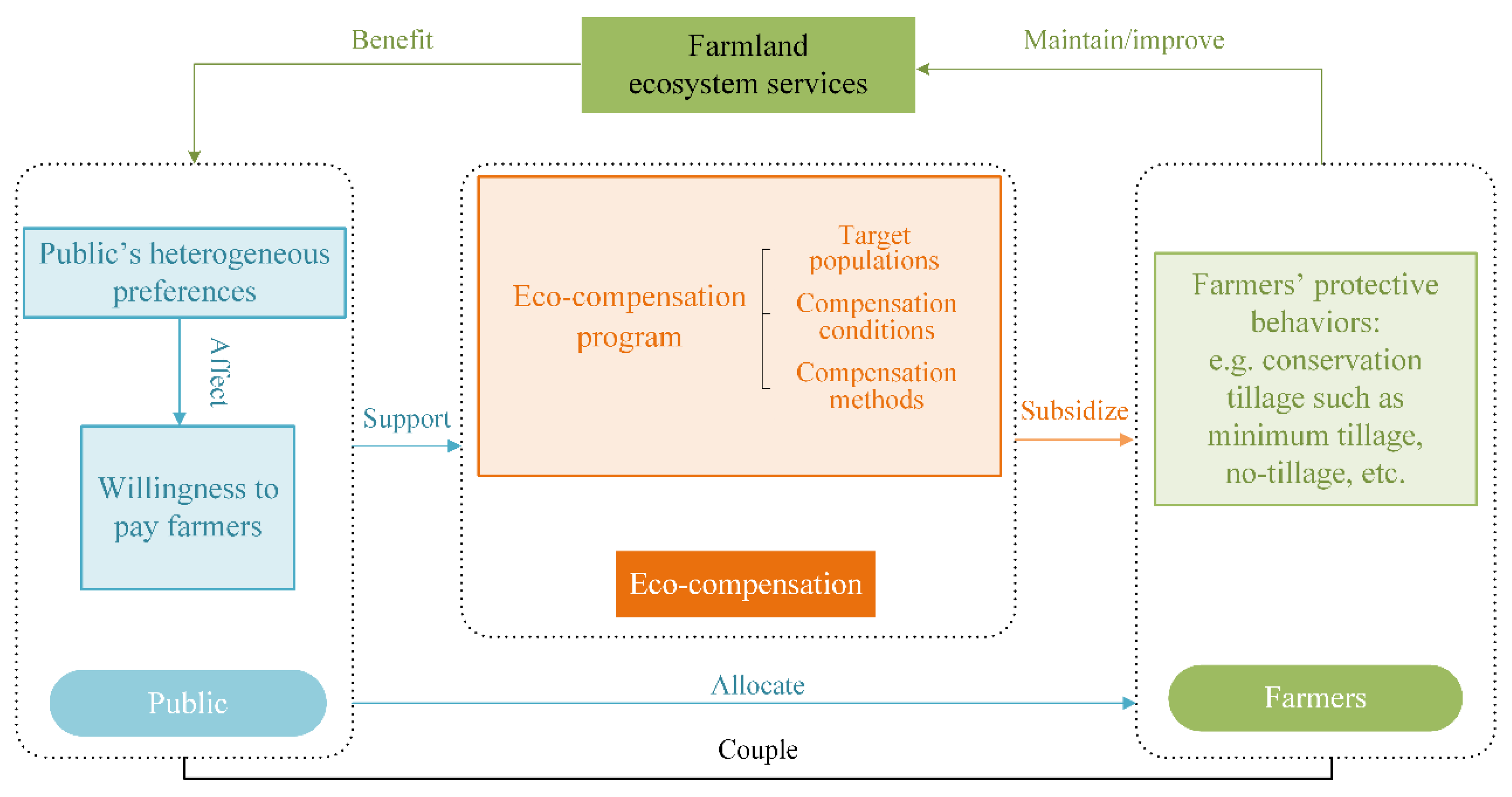
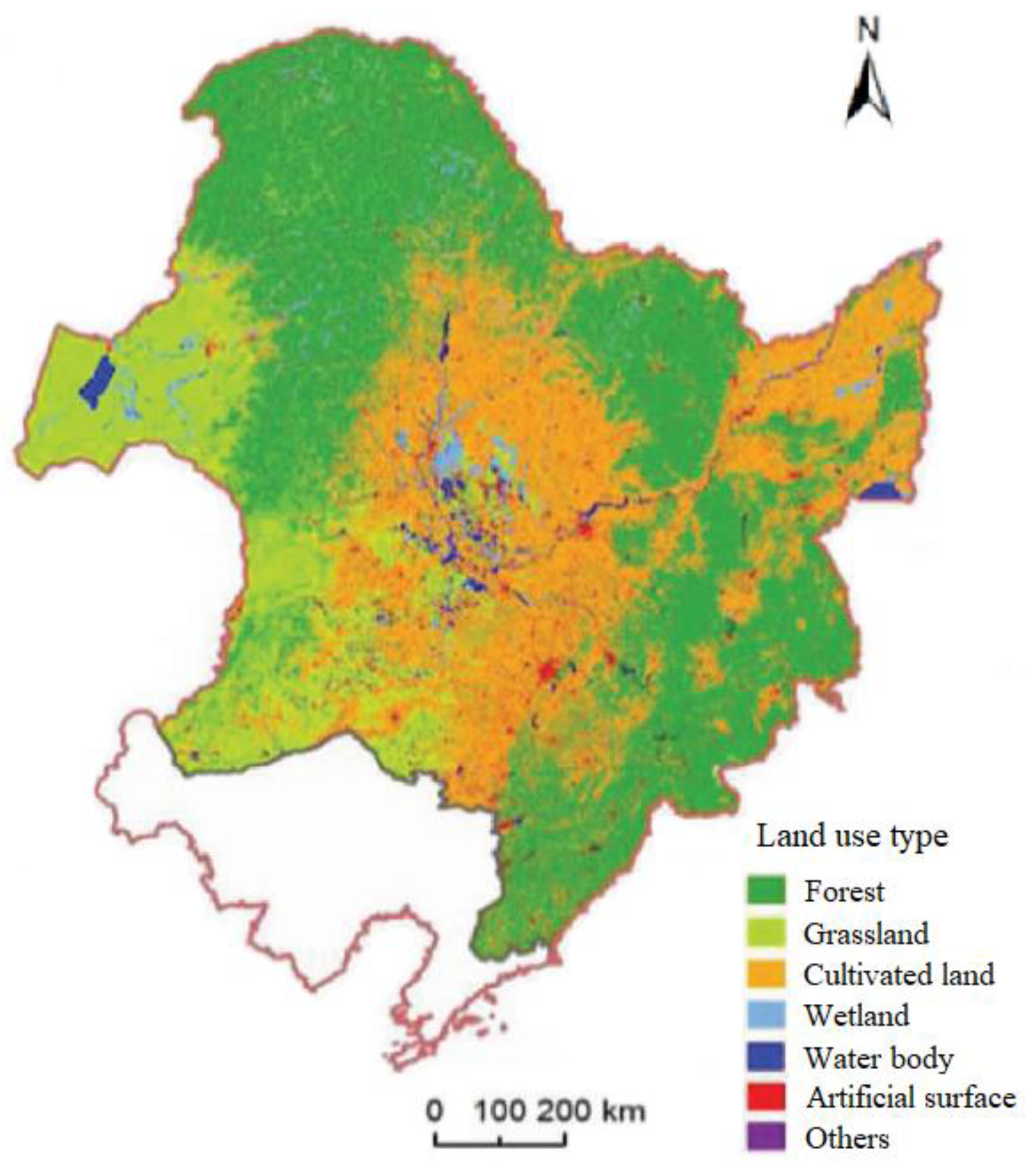
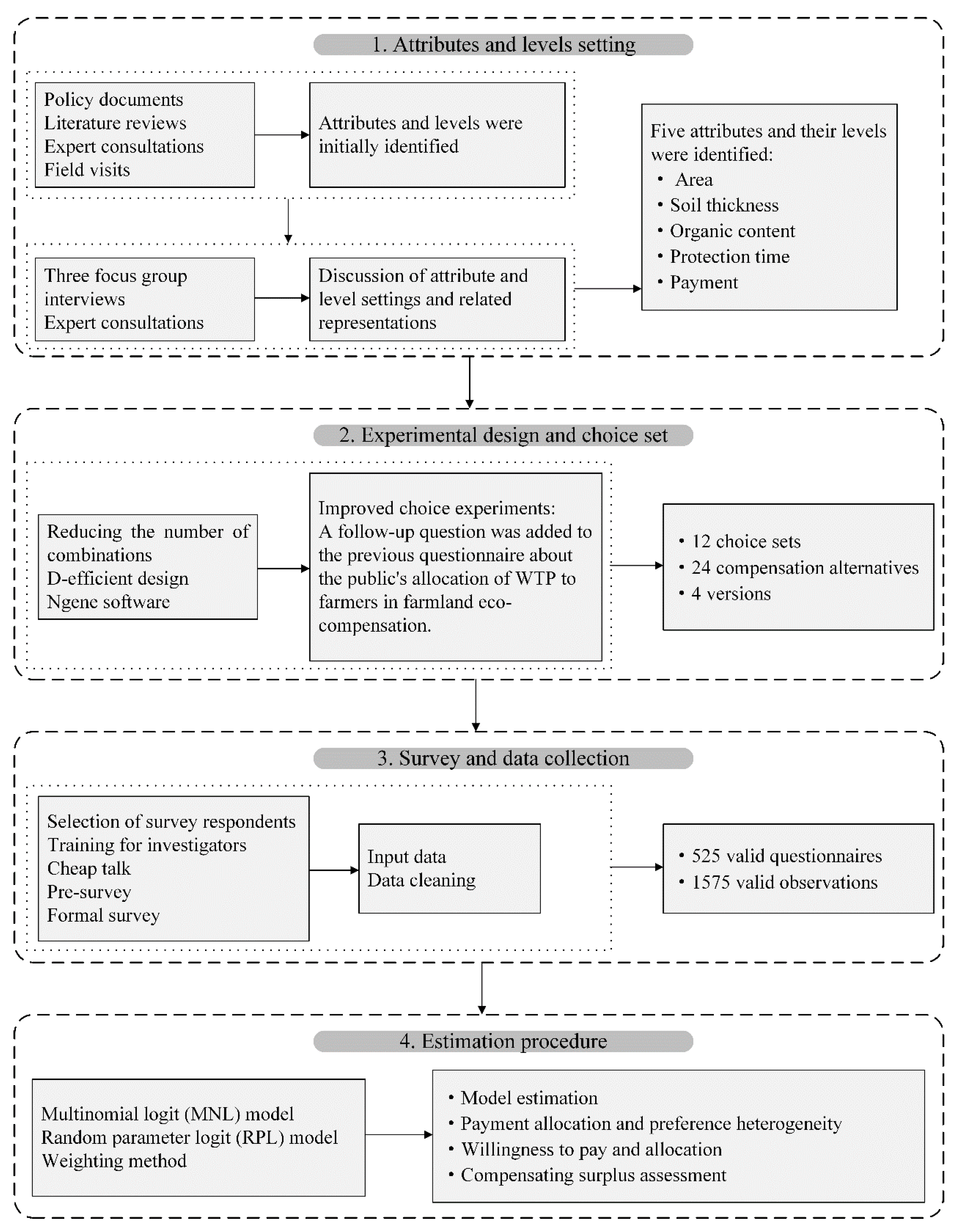
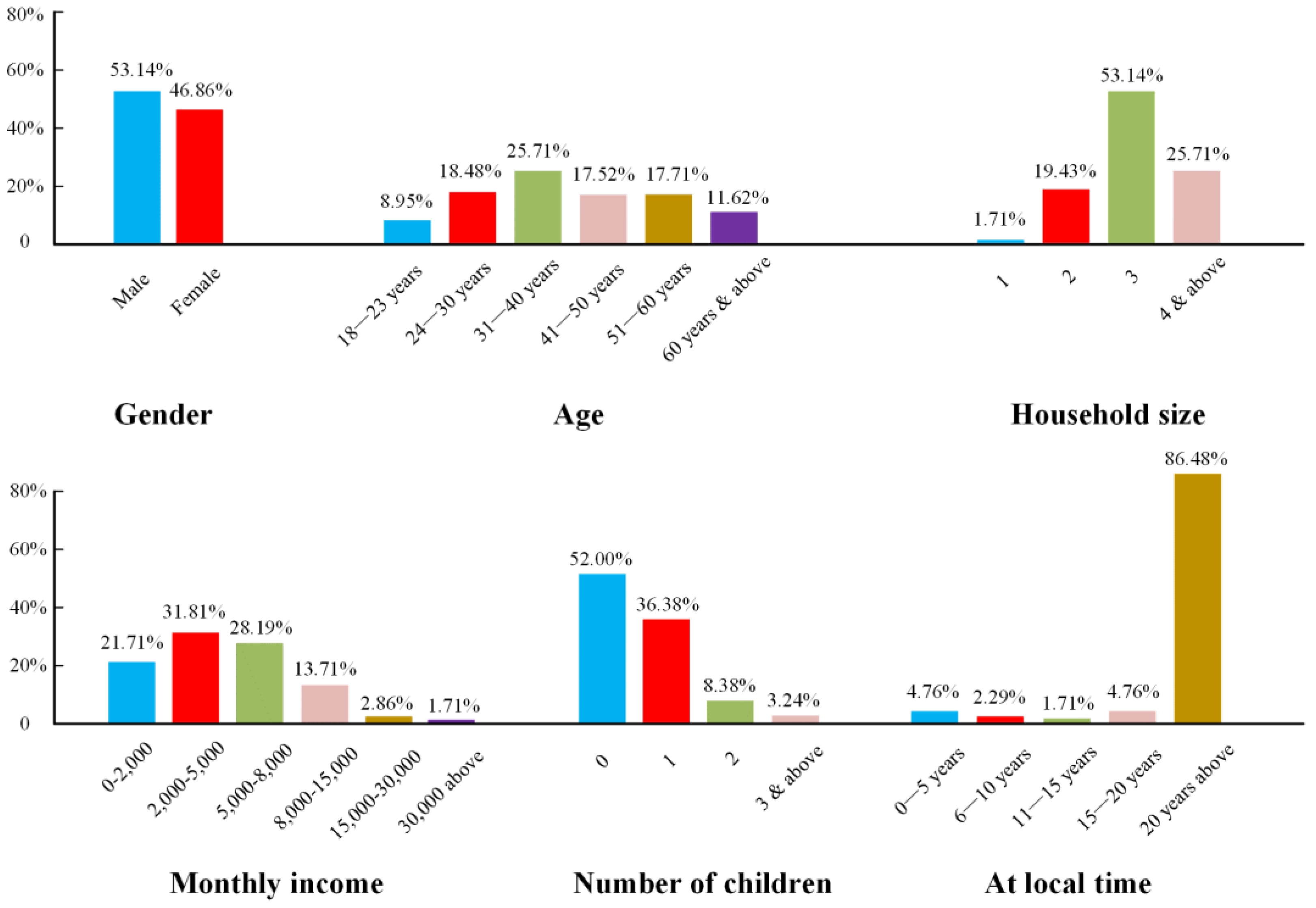
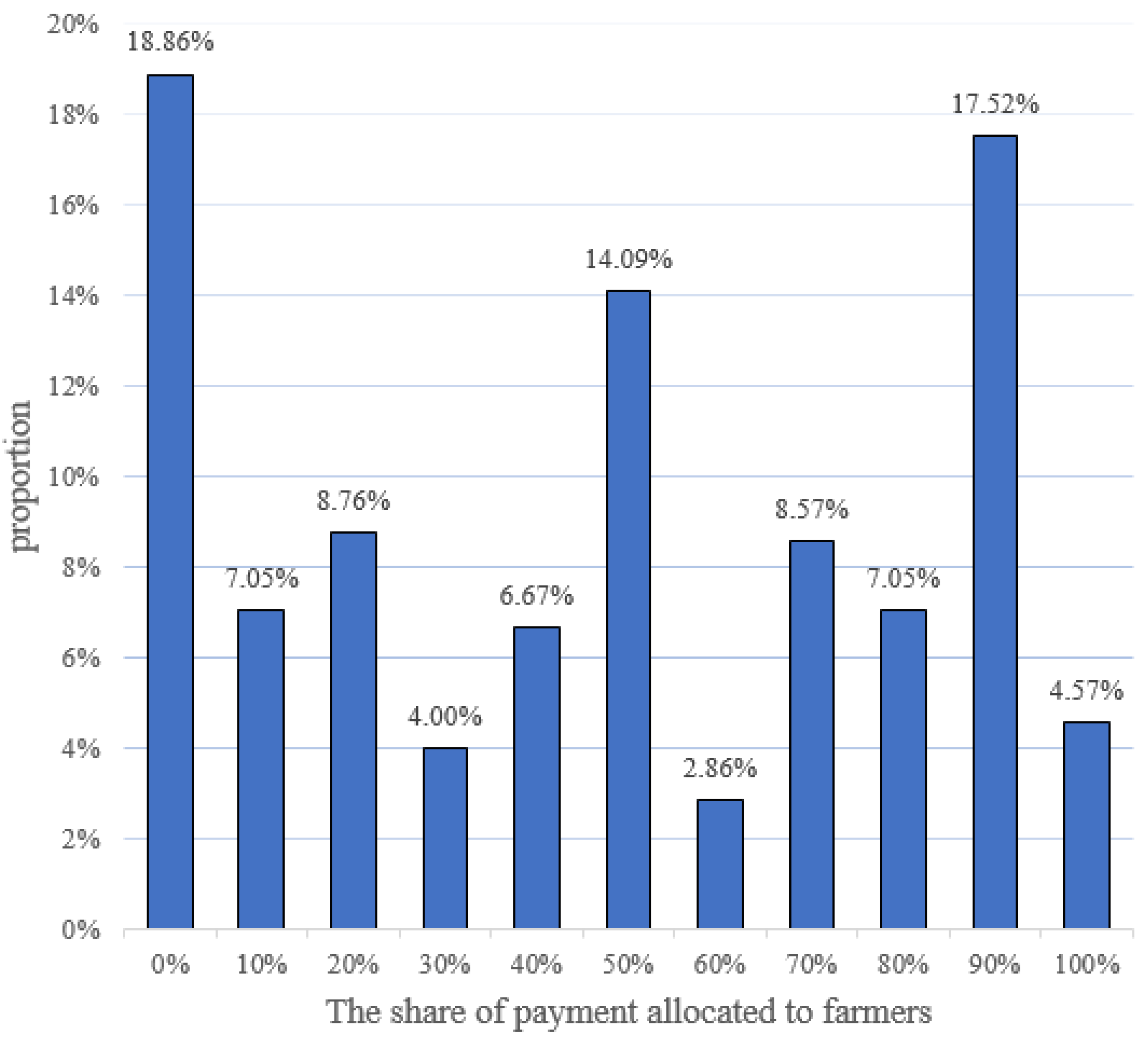
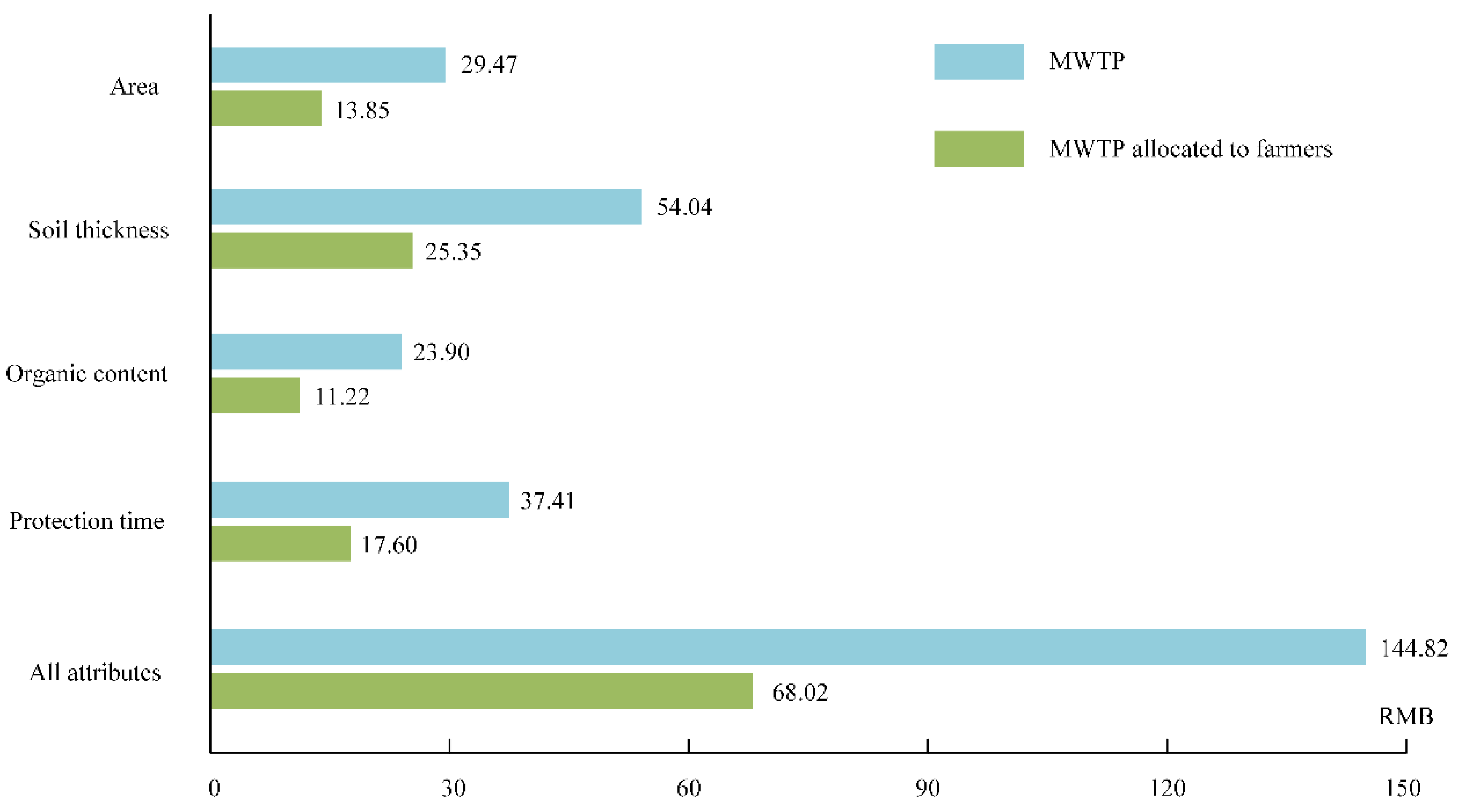
| Attributes | Descriptions | Levels |
|---|---|---|
| Area | The area of black soils refers to the farmland area normally used for cultivating crops in the black soil region. | 0 # Net increase 5% Net increase 10% |
| Soil thickness | The thickness of the black soils layer is one of the important indicators to evaluate soil fertility. | 0 # Net increase 5% Net increase 10% |
| Organic content | The organic matter content refers to the amount of various plant and animal residues in a unit volume of black soils, together with microorganisms and the organic matter synthesized by their decomposition. | 0 # Net increase 10% Net increase 20% |
| Protection time | The number of years required to achieve the goal of black soils eco-compensation. | 16 years # 13 years 10 years |
| Payment | Annual tax willingness to pay for farmland eco-compensation programs. | RMB 0 # RMB 200 RMB 400 RMB 600 RMB 800 RMB 1000 |
| Attributes | Compensation Alternative 1 | Compensation Alternative 2 | Alternative 3 |
|---|---|---|---|
| Area | Net increase 5‰ | Net increase 5‰ | Without any protection |
| Soil thickness | Net increase 10% | 0 | |
| Organic content | 0 | Net increase 10% | |
| Protection time | 13 years | 16 years | |
| Payment (year/household) | RMB 400 | RMB 800 | RMB 0 |
| Which of the alternatives do you prefer? | □ | □ | □ |
| In your payment, what share would you allocate to farmers to increase their motivation to protect black soils? | 0%□ 10%□ 20%□ 30%□ 40%□ 50%□ 60%□ 70%□ 80%□ 90%□ 100%□ | ||
| Variable | (a) MNL Model | (b) RPL Model | ||||
|---|---|---|---|---|---|---|
| Coefficient | Standard Error | Z | Coefficient | Standard Error | Z | |
| Random parameters in utility functions | ||||||
| Area | 0.0306 *** | 0.0082 | 3.72 | 0.0325 *** | 0.0087 | 3.76 |
| Soil thickness | 0.0441 *** | 0.0104 | 4.24 | 0.0495 *** | 0.0113 | 4.38 |
| Organic content | 0.0222 *** | 0.0047 | 4.70 | 0.0236 *** | 0.0049 | 4.79 |
| Protection time | −0.0332 ** | 0.0155 | −2.14 | −0.0364 ** | 0.0160 | −2.28 |
| Non-random parameters in utility functions | ||||||
| Payment | −0.0010 *** | 0.0001 | −6.96 | −0.0010 *** | 0.0002 | −7.09 |
| ASC | −5.4421 *** | 0.9642 | −5.64 | −5.4479 *** | 0.9754 | −5.59 |
| ASC_gender | 1.2593 *** | 0.3197 | 3.94 | 1.2581 *** | 0.3214 | 3.91 |
| ASC_age | 0.0872 | 0.0943 | 0.92 | 0.0844 | 0.0951 | 0.89 |
| ASC_household | −0.1131 | 0.1906 | −0.59 | −0.1105 | 0.1922 | −0.57 |
| ASC_income | 0.0133 | 0.1078 | 0.12 | 0.0152 | 0.1087 | 0.14 |
| ASC_children | 0.3656 * | 0.1969 | 1.86 | 0.3615 * | 0.1980 | 1.83 |
| ASC_year | 0.4400 *** | 0.1064 | 4.13 | 0.4447 *** | 0.1075 | 4.14 |
| Standard deviation of parameter distributions | ||||||
| Ts_area | 0.0325 *** | 0.0087 | 3.76 | |||
| Ts_soil thickness | 0.0495 *** | 0.0113 | 4.38 | |||
| Ts_organic content | 0.0236 *** | 0.0049 | 4.79 | |||
| Ts_protection time | 0.0364 ** | 0.0160 | 2.28 | |||
| Modeling statistics | ||||||
| Log likelihood | −1231.10 | −1229.21 | ||||
| AIC | 2508.2 | 2504.4 | ||||
| Rho-square | 0.0712 | 0.2896 | ||||
| Gender | Age | Household | Children | Year | Income | ||
|---|---|---|---|---|---|---|---|
| Payment share allocated to farmers | Pearson correlation | −0.006 | 0.048 ** | 0.111 ** | −0.038 ** | 0.051 ** | −0.066 ** |
| Significance | 0.674 | 0.001 | 0.000 | 0.008 | 0.001 | 0.000 |
| Scenario | Attributes | Compensation Amount | Compensation Surplus (RMB/Household/Year) | Compensation Amount Allocated to Farmers | Compensation Surplus Allocated to Farmers (RMB/Household/Year) |
|---|---|---|---|---|---|
| Scenario 1 | Area | 147.35 | 768.78 | 69.25 | 361.05 |
| Soil thickness | 270.20 | 126.75 | |||
| Organic content | 239.00 | 112.20 | |||
| Protection time | 112.23 | 52.80 | |||
| Scenario 2 | Area | 294.70 | 1537.56 | 138.50 | 722.10 |
| Soil thickness | 540.40 | 253.50 | |||
| Organic content | 478.00 | 224.40 | |||
| Protection time | 224.46 | 105.60 |
Disclaimer/Publisher’s Note: The statements, opinions and data contained in all publications are solely those of the individual author(s) and contributor(s) and not of MDPI and/or the editor(s). MDPI and/or the editor(s) disclaim responsibility for any injury to people or property resulting from any ideas, methods, instructions or products referred to in the content. |
© 2024 by the authors. Licensee MDPI, Basel, Switzerland. This article is an open access article distributed under the terms and conditions of the Creative Commons Attribution (CC BY) license (https://creativecommons.org/licenses/by/4.0/).
Share and Cite
Liu, B.; Xu, L.; Long, Y.; Wei, Y.; Ao, C. Public Willingness to Pay for Farmland Eco-Compensation and Allocation to Farmers: An Empirical Study from Northeast China. Agriculture 2024, 14, 1166. https://doi.org/10.3390/agriculture14071166
Liu B, Xu L, Long Y, Wei Y, Ao C. Public Willingness to Pay for Farmland Eco-Compensation and Allocation to Farmers: An Empirical Study from Northeast China. Agriculture. 2024; 14(7):1166. https://doi.org/10.3390/agriculture14071166
Chicago/Turabian StyleLiu, Baoqi, Lishan Xu, Yulin Long, Yuehua Wei, and Changlin Ao. 2024. "Public Willingness to Pay for Farmland Eco-Compensation and Allocation to Farmers: An Empirical Study from Northeast China" Agriculture 14, no. 7: 1166. https://doi.org/10.3390/agriculture14071166





